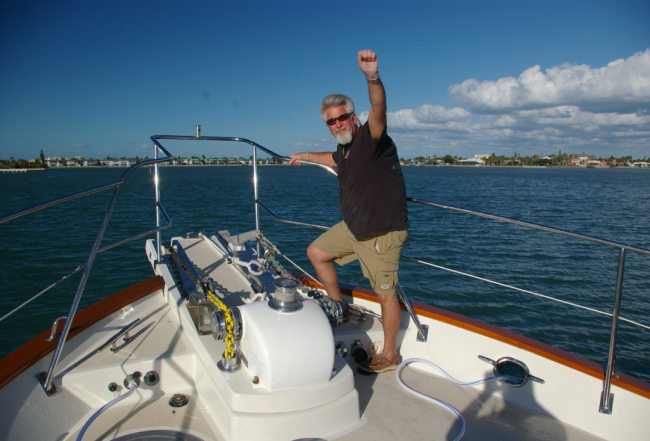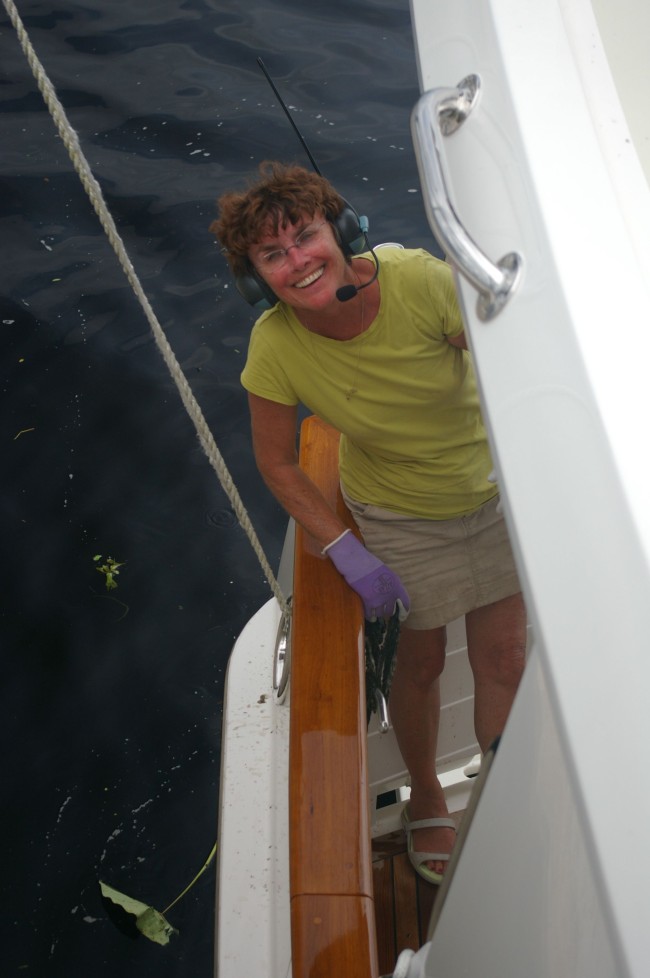
Remember the first time you and your mate went boating together? Amazing that any of us make it past that initial adventure….Oh sure, we start with such high hopes for the idyllic cruise and the thrill of taking the helm for the first time. But reality sets in when your mate says, "You want me to do what? Don't RAISE your voice at me!" To which you respond, "But you didn't hear me the first two times so I had to yell."
Things can get tense when you don't have full control and your mate doesn't do as you ask. So how can we turn this fiasco back around to living the dream of a peaceful cruiser? Some tips from a Boat Whisperer should do the trick.
First Walk the Walk
If you've never been the deckhand or the helmsman aboard your boat, then you really don't understand all the sightlines, responsibilities, difficulties or pleasures of that particular role. Besides the traumatic "what if something happens to him/her? What will I do?" it is just plain smart to learn about each other's boat jobs. Yes, boating is a job with tasks to accomplish for the aim of having fun, and the fun starts with understanding what needs to be done.
A helmsman who never works as a mate can't truly understand the time and motion needed to prepare or stow lines, the effort required to set an anchor or even why having a hand for the boat at all times is essential for staying on the dry side of the boat. Conversely, the mate who won't ever take the helm doesn't fully appreciate the moment-by-moment adjustments that current, wind and tide require in close quarters maneuvering. The novice must learn how easily words can be misinterpreted when they are said at the exact same moment that the VHF radio squawks or when a brisk wind carries the mate's words in the opposite direction of the helm.
"Safety first" is our mantra, and we believe everyone in your crew should prepare for the just-in-case. It's plain ole safe to know the basics of boating before you go and effective onboard communication is possibly the number one boating basic. We must begin with learning and accepting of each other's role.

Next, Talk the Talk
Now that you understand what needs to be done just talk to your helmsman or mate like a dog: "Sit!" "Stay!" "Come!" It really is this simple. Short, clear and consistent words work with dogs and humans. And if we are totally honest with ourselves, then we all know someone who has a hearing challenge. Maybe it's from playing our music too loud or maybe we are just of a certain generation. Either way, decluttering our language can only improve clarity of understanding with all parties involved, leaving nothing to interpretation….Mean what you say and say it clearly!
When you do speak, one method to be sure you were heard correctly is to echo. Helmsman says, "Bow line first." Mate echoes, "Bow line first." Next, the mate actually removes the bow line and says, "Bow line free." Helmsman echoes, "Bow line free." Notice we said this is one method; there are many other ways that work but rarely does this one backfire. Minimally you want an answer every time you speak. An acknowledgement from the listener allows the speaker to be confident that they were heard. (More on this later.)
Because many of our clients come from the corporate world, we discovered that debriefing is a wonderful part of onboard communicating. When the engines are shut down and the boat is secure we have a short discussion about the day, the docking, the anchoring. You get the drift…What did we do right and what could we change up for next time? Here's where the "good job" can be helpful if specifics are added to the comment: "Great job getting the midship line over the cleat on the first try! …A big whoo-hoo for the no-bump docking in that cross current!"
Some boaters swear by "marriage savers," also known as headsets/walkie talkies. While we do believe that this tool can enhance communication in a rather large boat, there are caveats that must be addressed every time they are used. Were the batteries charged enough in between use? Does the mate have the wires and radio secured well enough that they won't catch on anything and fall overboard while he/she handles lines? Are both units in the ON position? And most importantly, if you want to stay happy with each other, does everyone remember that what is said to a person on the dock can be heard by all crew members through the earpiece? It's awkward and sometimes downright impossible to take back something that was meant as an unheard aside. So, if you do decide on the headset route, have a secondary plan for communication when one of the above goes wrong.
Now We Are Walking AND Talking
So you've agreed on which simple words to use, but the boat is really big and you can't always see each other, much less hear what is said. Before you ever leave the dock be sure to do a full walk around. Get to know your vessel inside and out. Know how far away your stern is from the dock, just like you know where your car's front fender is even though you can't actually see it. The helmsman should know where the mate is standing when midship, forward and aft, even when the mate isn't actually visible. If the mate is leaving the sightlines of the helmsman, it is essential to communicate this: I am going forward on the port side. I am going aft to grab the binoculars. I am going below to the head. Each of these statements requires acknowledgement with an answer from the helmsman. Sound ridiculous?
Once upon a time a mate went below to use the head. She told her helmsman where she was going and he repeated it…Minutes passed….More minutes passed working toward a half an hour…Hmm? Where is the mate? Fortunately for the mate, we knew where she was supposed to be and indeed, found her stuck inside the head after the doorknob fell off inside the head. Only a few tense moments in this story, but you can imagine much darker outcomes from lack of onboard communication! We can think of a few instances where a simple acknowledgment works amazingly well off the boat too, but that's another story for another day.
Always point out landmarks, other boats and particularly the next navigation aid to your crew as if you were speaking to them by telephone. Using color descriptions and a clock reference with the bow at 12 o'clock and the stern at 6 o'clock gives more meaning. "Do you see the red marker at 10 o'clock just ahead of the blue small boat?" which requires a response: "Yes, I see it." Not: "Do you think I'm blind?"
So, if everyone saves the yelling for only when it is an emergency, then how do we get anyone's attention? We open hatches to the flybridge, side doors on the pilot house and do anything else that can improve our hearing. Try knocking on the side of the boat where you are standing. Then if the helmsman can step away from the wheel, your words may be easier to catch. And before you have apoplexy--Yes, the helmsman can step away from the wheel more often than you think.
Hand Signals Are for Land Lubbers
Swinging gently on anchor in a well-protected cove is a boater's stuff of dreams, but those dreams become nightmares when the yelling begins. A few simple ARM signals can help keep the peace. We emphasize arm vs hand signals because there is less to interpret with large sweeping motions. When standing on the bow a crew member extends the entire arm forward to indicate "drive ahead." A raised arm with a fist on the end clearly means "neutral" on our boat. These arm signals offer strong communication from crew with no need to speak or even look at the helmsman. All focus can be on the task at hand when lowering and raising the anchor.
If you have a bow thruster and you would like just a quick thrust to the left, then lower your left arm to your side and tap your left hip followed by pointing left. Your cove mates will be impressed that the only thing that's interrupted their peace is the purr of your engines before the splash of your hook.
Practice Really Does Make Perfect
Practice helps build confidence and sets good habits, including how to communicate with each other. Acknowledgement is the part we most need to get right. Were you heard?
Remember, this is a job, the best job you can ever think of, and, if it is performed, the result is FUN! So let's go cruising!
Captains Chris & Alyse Caldwell are USCG 100-ton Masters and Cruising Coaches who offer Personal Boat Training Online or Onboard your boat anywhere! The Caldwell's help build your cruising confidence with hands-on training and with their AskCaptainChris.com training videos filled with tons of tips for the boater who loves learning. If you have additional questions for Captains Chris or Alyse, please email them at chris@captainchrisyachtservices.com.












